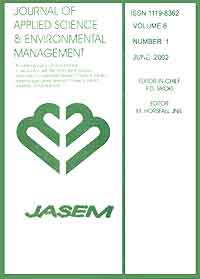
|
Journal of Applied Sciences and Environmental Management
World Bank assisted National Agricultural Research Project (NARP) - University of Port Harcourt
ISSN: 1119-8362
Vol. 22, No. 1, 2018, pp. 47-53
|
 Bioline Code: ja18009
Bioline Code: ja18009
Full paper language: English
Document type: Research Article
Document available free of charge
|
|
|
Journal of Applied Sciences and Environmental Management, Vol. 22, No. 1, 2018, pp. 47-53
| en |
Utilization of Nkpuma-Akpatakpa clay in ceramics: characterization and microstructural studies
ITUMA, CG; ETUKUDOH, AB; ABUH, MA; AKPOMIE, KG & OBIOHA, CI
Abstract
Nkpuma – Akpatakpa clay was analysed for its ceramics suitability. Chemical, mechanical and spectral
characterization of the clay was carried out to obtain more information from this clay found in commercial quantity at Ebonyi
State Nigeria. The XRD analysis showed that the principal minerals in the clay are quartz, qandilite, aragonite, Muscovite
and anatase. FTIR showed the stretching vibrations for Si – O at 685.8cm – 1 showing the presence of Quartz. The frequency
at 1431cm-1 is due to (CO3)2- stretching mode vibration or C – O stretching of Aragonite and the band at 2467.6 is due to
OH- stretching. Bands observed at 984.7 and 987.7cm – 1 correspond to Al – O bending vibrations which suggest the presence
of muscovite in the clay and SEM studies were also carried out and reported. Porosity of the clay was 0.88% considered too
small for refractory, thermal insulation and other high porosity desired ceramics applications. Value obtained for Fe2O3 was
> 1.7% which accounted for why the clay did not fire white. The values for M.O.R was >40KgF/cm2. The refractoriness
was <13400C. Chemical characterization showed the presence of fluxing oxides at elevated levels which are responsible for
the poor refractoriness and limits the utilization of the clay to low or mid-temperature ceramics products.
Keywords
Nkpuma-Akpatakpa clay; Ceramics; Characterization; Qandilite; FTIR; Bulk density
|
| |
© Copyright 2017 - Ituma et al.
|
|
